HI guys - quick question from brand new metallic reloader.
I have settled on a charge weight and MV, and now would like to explore impact of seating depth.
Its Berger 140 gr Hybrid Targets in a 6.5 man bun Proof SS barrel with 1,400 rounds on it. Seating .010 off of max mag length gives about .060 off of lands.
I have read a number of folks who have expressed that this bullet is pretty jump tolerant and that many are running .100 off or even more.
Right now my plan is to increment up by .010 from .060 to .100 off of lands with ten cartridges loaded at each depth to allow two five shot groups....yeah, I'm not good enough of a marksman to utterly eliminate my shooting from ammo performance so I'm thinking shoot two groups of five.
But, is this too big of an increment between depths such that I'll miss the best depth. Do I need/should reduce the depth increment to maybe like .005?
Thanks
I have settled on a charge weight and MV, and now would like to explore impact of seating depth.
Its Berger 140 gr Hybrid Targets in a 6.5 man bun Proof SS barrel with 1,400 rounds on it. Seating .010 off of max mag length gives about .060 off of lands.
I have read a number of folks who have expressed that this bullet is pretty jump tolerant and that many are running .100 off or even more.
Right now my plan is to increment up by .010 from .060 to .100 off of lands with ten cartridges loaded at each depth to allow two five shot groups....yeah, I'm not good enough of a marksman to utterly eliminate my shooting from ammo performance so I'm thinking shoot two groups of five.
But, is this too big of an increment between depths such that I'll miss the best depth. Do I need/should reduce the depth increment to maybe like .005?
Thanks


